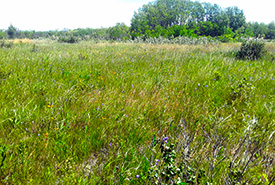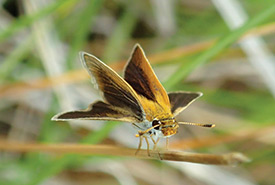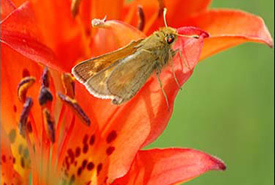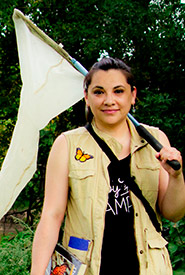Experiencing Canada’s prairie grasslands for the first time

Tall grass prairie in Manitoba (Photo by Jessica Sánchez-Jasso)
Colourful, surprising and full of life, grasslands of the Canadian Prairies are one of a kind. My first visit there deepened my passion for biology and reminded me why I fell in love with this field. From my earliest memories, I can recall spending countless hours in my grandmother's garden in Mexico, where I grew up, savouring the sweet and juicy peaches from a grand tree that nourished us and gave us cherished memories. It was during those moments that I developed a keen eye for observing the fascinating insects, plants and birds that visited our garden. Perhaps these experiences sparked my deep love for nature and set the course for my future as a biologist.

Poweshiek skipperling (Photo by Rachel Carol)
I’m Jessica, a Weston Family Conservation Science Fellow with the Nature Conservancy of Canada (NCC) and PhD student at the University of Manitoba. In 2022, I visited Manitoba’s Tall Grass Prairie Natural Area to learn how to identify butterfly and plant species for my research. It was an amazing experience; the Prairies truly surprised me. With each step I took, a whole new world unfolded before me, revealing vibrant flowers and insects of different colours and shapes that I had never seen before. I also encountered a young black bear, and I had the pleasure of observing numerous birds, from the charming savannah sparrow to the majestic great blue heron.
Sadly, Prairie grasslands are among the world's most depleted and threatened ecosystems. This has resulted in many species facing risk of extinction, including Poweshiek skipperling and Dakota skipper. These two butterfly species rely entirely on the habitat here for survival.
One of the many reasons for my interest in grasslands is their adaptation to natural disturbances, such as wildfires and grazing. In fact, disturbances play a crucial role in keeping grasslands healthy. The absence of natural disturbances can trigger a chain reaction, resulting in habitat loss and species extinction. Without wildfire, for example, bushes, trees and plants from other places can spread and displace the unique plants that live in the prairie. As native plants disappear, so do the animals that depend on them.

Wood lily (Photo by Jessica Sánchez-Jasso)
To prevent the extinction of Poweshiek skipperling and Dakota skipper, recovery strategies have been established under the Species at Risk Act, focused on preserving and restoring prairie habitat. This involves implementing management practices such as controlled burns, cattle grazing, and mowing, all aimed at replicating natural disturbances. However, these disturbances can also have negative effects on the survival of butterflies. For that reason, it is crucial to understand to what extent land management practices are effective in protecting and restoring grassland habitat for both endangered butterflies.

Crab spider (Jessica Sánchez-Jasso)
My research aims to evaluate different management activities in sites where Poweshiek skipperling and Dakota skipper currently live and where they used to live. To complete my research, I will return to the Prairies for two more years to collect data on the plants that are essential for both butterfly species, while evaluating soil quality and fertility. I will also search for species that might compete for the same plants, or prey on caterpillars or adults of these butterfly species. Additionally, I will incorporate data collected from butterfly surveys (conducted by NCC and the Assiniboine Park Zoo) in order to conduct my analysis.
How do butterflies respond to grazing by cattle, controlled burns or mowing? How do they interact with plants, soil and other animals? By exploring these questions, we can gain insight into the effectiveness of management practices in maintaining the balance and health of the Prairies.

Dakota skipper (Photo by Phil Delphey/Wikimedia Commons)
My research will aid in decision-making for management practices, butterfly releases in their original habitat, and NCC’s work connecting butterfly habitat.
Every time I find myself in the Canadian Prairies, I feel the same sense of wonder for nature that I experienced in my grandmother’s garden when I was a kid. These rare and vulnerable grasslands sparked a curiosity in me that grows with every new discovery, igniting my passion for exploration and my love for nature.
This research is made possible through the generosity of the Weston Family Foundation, which supports the Weston Family Conservation Science Fellowship Program. This research is part of a larger collaborative project between the University of Manitoba, University of Winnipeg and Nature Conservancy of Canada.
Further reading
Tall Grass Prairie Species at Risk (NCC)
Tall Grass Prairie Natural Area Conservation Plan (NCC)
Interlake Natural Area Conservation Plan (NCC)
Recovery Strategy for the Poweshiek Skipperling (Environment Canada)
Recovery Strategy for the Dakota Skipper (Environment Canada)


